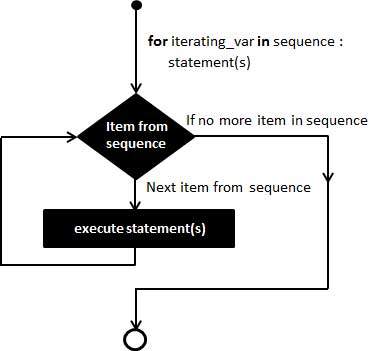Python3 for循環語句
Python中的 for 語句可用來迭代任何序列中的項目,如列表或字符串。
語法
for iterating_var in sequence:
statements(s)
如果一個序列中包含一個表達式列表時,它需要首先計算。然後,序列中的第一項被分配給所述迭代變量iterating_var,接下來, 語句塊被執行。 列表中的每一項都被分配到iterating_var, 並執行語句( statement)塊,直到整個序列完成。
流程圖

range()函數
內置函數range() 是迭代數字序列的函數。它產生算術數列迭代器。
>>> range(5)
range(0, 5)
list(range(5))
[0, 1, 2, 3, 4]
range() 生成一個迭代從0開始到 n-1 的整數。要獲得序列的列表對象,它可以強制轉換爲list()。現在,這個列表可以使用 for 語句遍歷
>>> for var in list(range(5)):
print (var)
這將產生以下輸出
0
1
2
3
4
示例
#!/usr/bin/python3
for letter in 'Python': # traversal of a string sequence
print ('Current Letter :', letter)
print()
fruits = ['banana', 'apple', 'mango']
for fruit in fruits: # traversal of List sequence
print ('Current fruit :', fruit)
print ("Good bye!")
當執行上面的代碼,它產生以下結果 -
Current Letter : P
Current Letter : y
Current Letter : t
Current Letter : h
Current Letter : o
Current Letter : n
Current fruit : banana
Current fruit : apple
Current fruit : mango
Good bye!
通過序列索引進行遍歷
另一種方式是通過索引偏移迭代序列的每個項目。下面是一個簡單的例子 -
#!/usr/bin/python3
fruits = ['banana', 'apple', 'mango']
for index in range(len(fruits)):
print ('Current fruit :', fruits[index])
print ("Good bye!")
當執行上面的代碼,它產生以下結果 -
Current fruit : banana
Current fruit : apple
Current fruit : mango
Good bye!
在這裏,我們使用了 len() 的內置函數,它用來計算元組的元素總數,以及 range() 內置函數用來遍歷序列順序。
for循環使用else語句
Python支持在循環語句相關聯else語句
如果else語句和for循環語句一起使用,else塊只在 for 循環正常終止時執行(而不是遇到break語句)。
如果else語句用在 while循環中,當條件變爲 False 時,則執行else語句。
下面的例子說明了一個else語句和for語句相結合使用,在給定的列表數中搜索偶數。
#!/usr/bin/python3
numbers=[11,33,55,39,55,75,37,21,23,41,13]
for num in numbers:
if num%2==0:
print ('the list contains an even number')
break
else:
print ('the list doesnot contain even number')
當執行上面的代碼,它產生以下結果 -
the list doesnot contain even number